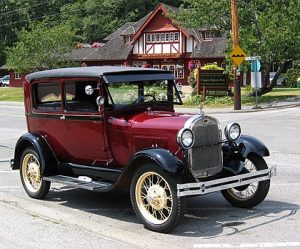( Continued accounts of Henry Taylor’s experiences as a Fire Ranger)
We were plagued with a lot of fires on Sundays, often caused by cigarettes being thrown from cars. Those roads were just the width of the wheel tracks and when a cigarette was thrown out it went into the dry grass and brush. The only redeeming feature was that the fire was easy to get to and you had one side with a good fire guard on the road way. It was an awful job, though, to gather a gang of fire fighters on a Sunday. They were away from home visiting, or in Church and all dressed up so they didn’t want to get their good clothes dirty.
I only had one real good satisfaction in gathering a gang one Sunday morning. The Raglan fire tower picked up smoke in the south end of Raglan Township. It was at a saw mill site. During the week we never paid attention to the smoke of the steam driven saw mill but on Sunday the smoke there meant trouble. So, to make sure of its location, we got a reading on it from the Quadeville Tower. Then I knew that fire was right at that sawmill owned by a Mr. Liedtke. So I jumped into the Model T and took off. I never tried to pick up any men along the road. Instead I made straight for the little Lutheran Church near Schutt. When I drove into the yard one of the ushers stuck his head out of the church door. I told him that if Liedtke and his men were in church there that they had better get out and going for there was a fire at their saw mill. Well in no time flat that preacher was preaching to a bunch of empty pews. The men piled into that old Ford of mine until the hind springs were down to the axle.
The hill going south from that church is about a mile long. When I was nearly to the top of it the Ford conked out for want of gas. With the back end of the car sagging so low with my load, and the long hill, the gas couldn’t get to the carburetor. ( You see, those old Ford cars had the gas tank under the front seat with a gravity feed. But on a steep hill and with the added weight of the men in the back seat the gas couldn’t run up hill to the carburetor. ) So I backed into the ditch where it was level, and the carburetor filled with gas. One of the lads cranked it up and away we went again. From there on in to the fire I got some of the men to get out of the back seat and stand on the running board up nearer the windshield to keep the car on a level.
As soon as I could after that I drilled the gas cap on the tank and put a bicycle tire valve in it. I then used the tire pump to put some air pressure in the gas tank.
When we got to the mill site we found that the fire had run along the creek bank and was under a skidway of dry cedar, 8 foot logs. Some of the logs were on fire, right at the corner of the mill. So we got the cant hooks from the saw mill and rolled the burning logs into the creek. That way we saved the saw mill.
When we got done with the fire those church men were a pretty dirty looking bunch. They hadn’t had time to take off their Sunday clothes before fighting the fire. But they were a happy bunch of lads for they had their saw mill and a job on Monday morning.
That fire, like so many, was caused by a fisherman’s carelessness in leaving a camp fire burning on the bank of the creek.
In 1931 I traded that Model T Ford in at the Ford Garage in Bancroft for a Model A Ford. It cost me $600.00, and Bob Stringer allowed me $120.00 for the 1925 Model T. So I had that Model T Ford for 2 years of Ranging, for nothing. If a man got a deal like that now he would be liable to faint. That Model A Ford car only cost me $480.00 and the Model T. I wish now that I had kept that Model T Ford for it would have been worth a lot as an antique.
To put that Model A car on the road I only had to put a $5.00 licence on it. Now the insurance on my little red truck was $675.00. That insurance is $75.00 more than I paid for the whole car in 1931!

